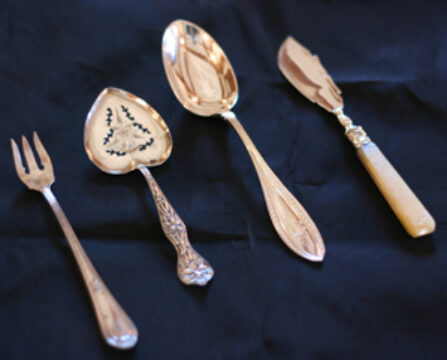
During March, Rosenberg Library displayed an eclectic assortment of Victorian-era cutlery including antique spoons, forks, and knives made of high-quality silver.
With an abundance of fast-food restaurants, food trucks, and drive-through windows, it’s hard to imagine devoting several hours at the end of a busy day to sitting down at an elaborately set dining table and eating multiple courses of food on a regular basis. In modern times, we generally use just three utensils during a meal: a spoon, a fork, and a knife. But in the past, fine dining required a multitude of specialized cutlery for the consumption of particular foods.
European-style formal dining was a means of demonstrating one’s wealth and social status during medieval times. Members of the elite class began to use utensils for eating rather than simply using their fingers. Spoons cast from silver became popular baptismal gifts among the wealthy, hence the phrase “born with a silver spoon.” Forks came along later, originating from Italy in the 17th century. Eliminating the need for picking up food with one’s fingers, forks provided a more delicate, much cleaner eating experience.
By the Victorian age, dinner parties had evolved into carefully orchestrated pageant-like affairs. Formal attire was required for evening meals served after 6 o’clock. These dinners provided the host and hostess an opportunity to display all of their fine china and silver, and it was not uncommon for each diner to be provided with a 24-piece place setting. Up to 8 different forks, 8 different knives, various spoons, and multiple drinking glasses were set out for individual guests.

Often consisting of 9 or so courses, dinners lasted for several hours. Time was allotted between each course to allow for digestion and conversation. At the conclusion of the meal, servers provided bowls of water with lemon for guests to freshen their hands. It was customary for ladies to retire to the drawing room while men would remain at the table or enter the library for fine cigars and port wine.
There are two main styles of dining service which continue to be used today: service a la francaise and service a la russe. The French style came about first, with a variety of dishes brought from the kitchen at once and placed together on the table. The dinner was usually served in three courses beginning with soup and fish, followed by roasts, and ending with desserts. Guests would select which types of foods they wished to eat and served themselves. Present-day buffets and family-style dinner services evolved from the French method.
Service a la russe developed during the 19th century and allowed for a more streamlined dinner service. The Russian style called for different foods to be brought out sequentially and served individually to guests who remained seated at the table. Each place setting was pre-set with a name card, a dinner plate, and a rolled napkin. Silverware was placed on each side of the plate, with the exception of the dessert spoon which was brought out once dessert was served. Multiple wine glasses, water goblets, a salt cellar, a nut dish, and a menu were set at each seat.
To the right of the plate, from the outside in were placed the oyster fork, a soup spoon, a fish knife, a meat knife, and a salad/fruit knife. On the left side, from outside in were the fish fork, meat fork, and salad/fruit fork. While restaurants today bring out food-filled plates to diners, it was considered poor taste to pre-serve guests, as they could not dictate the amount of food they wished to eat.
Although most of us lack the time, energy, and the household staff needed to prepare and serve a 3-hour, 9-course meal, people today still enjoy food and the dining experience as much as people in the past — just with a few less forks on the table.